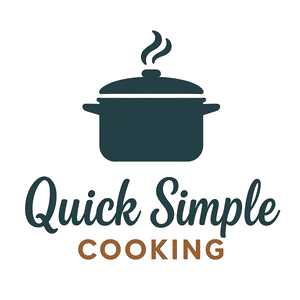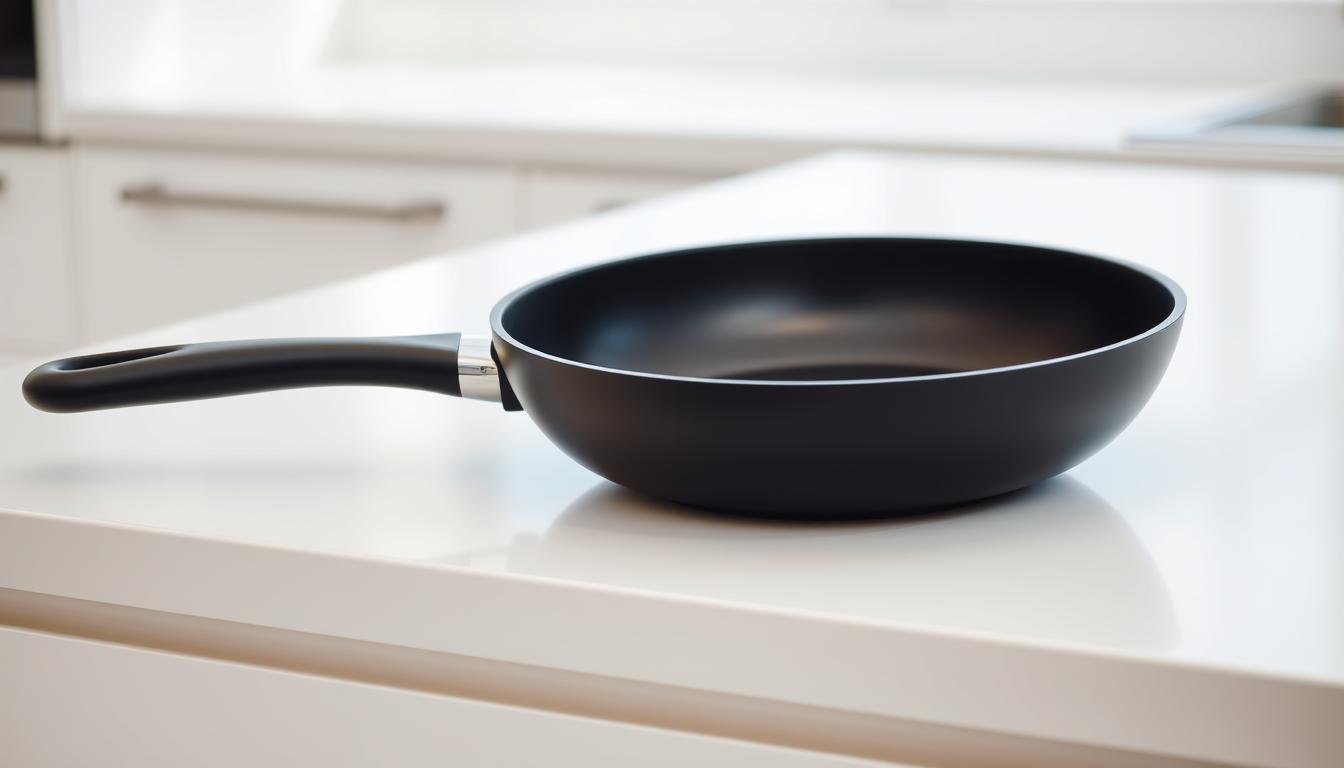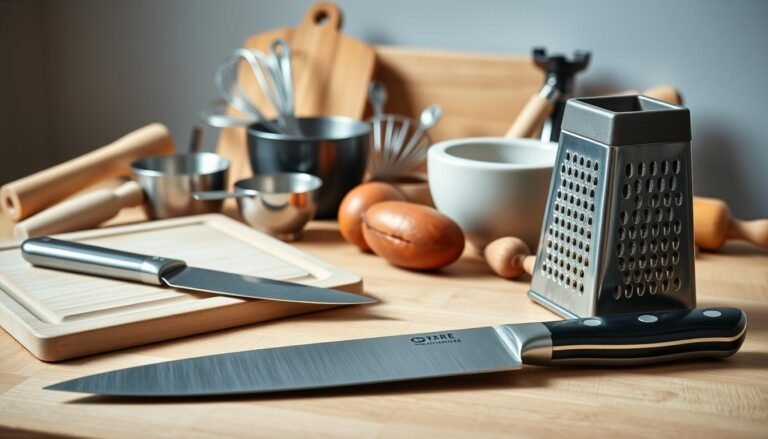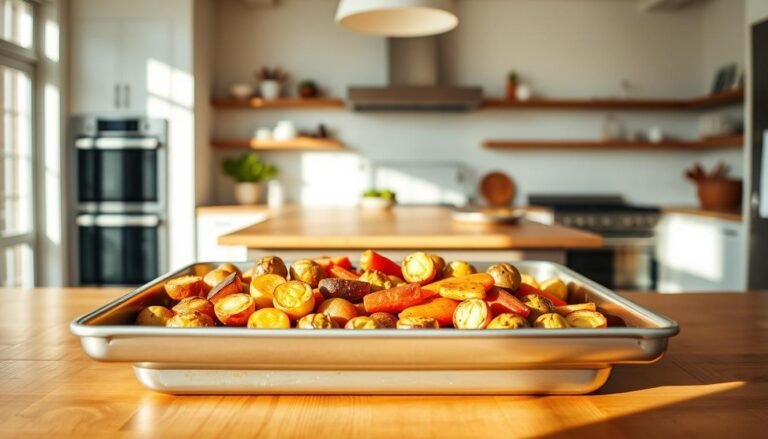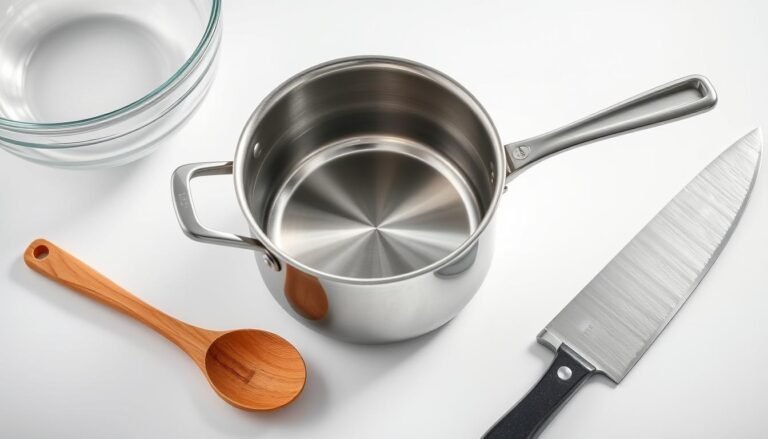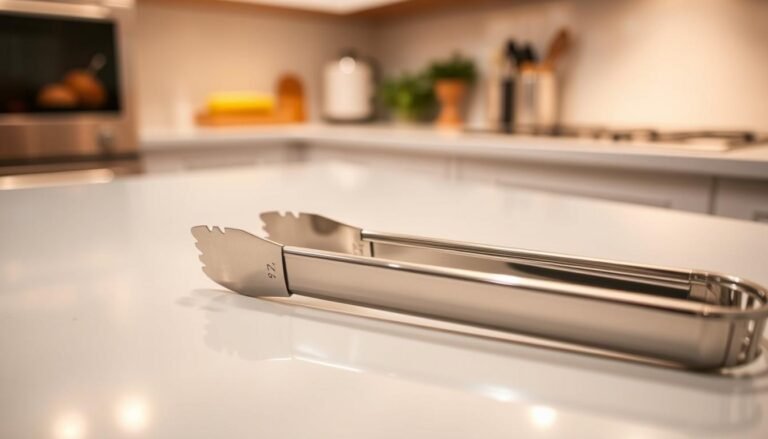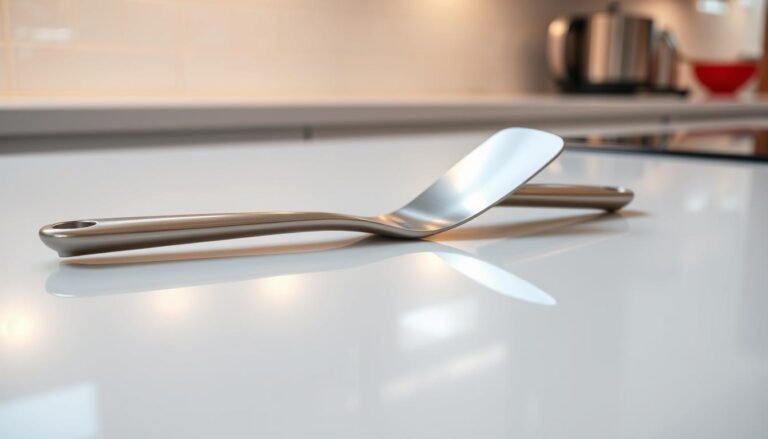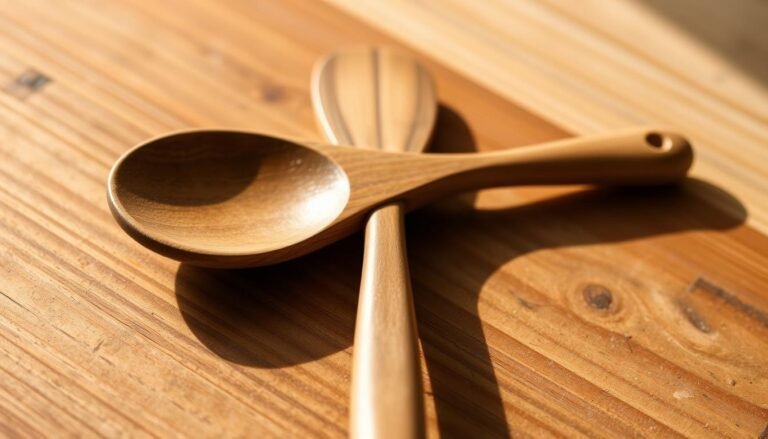Disclosure: This Post Contains Affiliate Links; We earn a commission on purchases.
Cooking is more fun with the right tools. A nonstick frying pan makes cooking and cleaning easy. Experts at Epicurious say it’s a must-have for home cooks.
A nonstick skillet lets your food cook perfectly without sticking. This makes cooking easier and cleaning up a snap. If you’re looking to improve your kitchen, check out recommended products.
Key Takeaways
- A nonstick frying pan is a versatile tool for various cooking techniques.
- Easy food release and cleanup are significant benefits of nonstick cookware.
- Choosing the right nonstick skillet can enhance your cooking experience.
- Nonstick pans are ideal for cooking delicate foods like eggs and pancakes.
- Proper care can extend the lifespan of your nonstick frying pan.
The Revolution of Nonstick Cookware in Modern Kitchens
Nonstick coatings have changed cooking a lot. They make it easy to cook many dishes with little cleanup. Nonstick frying pans are now a key part of kitchens everywhere because they are so handy and versatile.
What Makes a Frying Pan “Nonstick”
Nonstick pans use PTFE (Teflon) and ceramic coatings. PTFE is great at not sticking, and ceramic is better for the planet. Making these coatings involves many steps to make them last and work well.
Over time, making nonstick pans has gotten better. Now, some pans have stronger coatings that can handle scratches and high heat better.
Key Benefits for Everyday Cooking
Nonstick frying pans have many good points for daily cooking. They include:
- Food comes out easily, making it simple to cook things like eggs and pancakes.
- Cleaning up is a snap because food doesn’t stick to the pan.
- You need less oil, which is healthier.
- They’re good for many cooking methods, like frying, sautéing, and baking.
If you want to get better cookware, learning about new nonstick tech is smart. Check out Revolutionizing the Kitchen: The Future of Frying Pans in.
Knowing how nonstick pans work helps cooks choose better. It makes cooking better for everyone.
Types of Nonstick Frying Pans Available Today
Nonstick frying pans come in many types. Each has its own benefits. You can pick the best nonstick frying pan for your cooking.
Traditional PTFE (Teflon) Coated Pans
PTFE, or Teflon, has been around for a long time. It makes food not stick, making cooking and cleaning easy. PTFE-coated pans are good for cooking with little fat. But, they might not last as long as others and can get damaged by high heat.
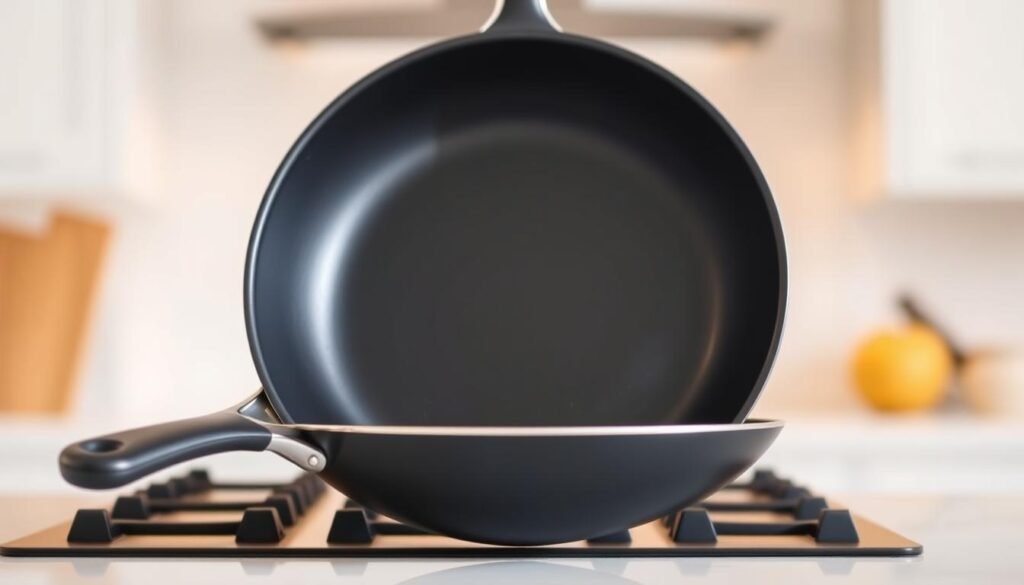
Ceramic Nonstick Pans: The Eco-Friendly Alternative
Ceramic nonstick pans are a green choice. They’re made from natural stuff and don’t have PFOA or PTFE. Ceramic nonstick pans cook food evenly and are safe. But, they need more care than other pans.
Hard-Anodized Aluminum Nonstick Cookware
Hard-anodized aluminum pans are strong and heat up well. They’re used in many professional kitchens. Hard-anodized aluminum nonstick pans last long and don’t scratch easily. They’re perfect for those who cook a lot.
Nonstick Frying Pan Sets: Value and Versatility
Nonstick frying pan sets are great for upgrading your kitchen. They come with different sizes of pans. A nonstick frying pan set lets you cook many dishes easily. It’s a smart way to get a lot of cookware without spending too much.
When picking a nonstick frying pan, think about how you cook. Knowing the different types helps you choose the right one. This way, you get the best nonstick cookware for your needs.
Choosing the Best Nonstick Frying Pan for Your Needs
Finding the right nonstick frying pan is important. It should be good for cooking and last a long time. Whether you cook a lot or just sometimes, the right pan makes a big difference.
Essential Features to Consider
When picking a nonstick frying pan, look at a few key things. These are the pan’s size and weight, the handle’s design, and if it comes with a lid or other extras.
Size and Weight
The size and weight of a nonstick skillet matter a lot. Light pans are easier to move, which is great for those who are not as strong. But, heavier pans might be more stable when you’re cooking.
Handle Design and Heat Resistance
The handle’s design is also very important. A handle that stays cool is a big plus, as it makes handling the pan safer at high heat. Look for handles that are comfortable and stay cool.
Lids and Accessories
Some pans come with lids, which are handy for cooking methods like braising or steaming. Make sure the pan works well with different cooking methods and if it comes with extra accessories.
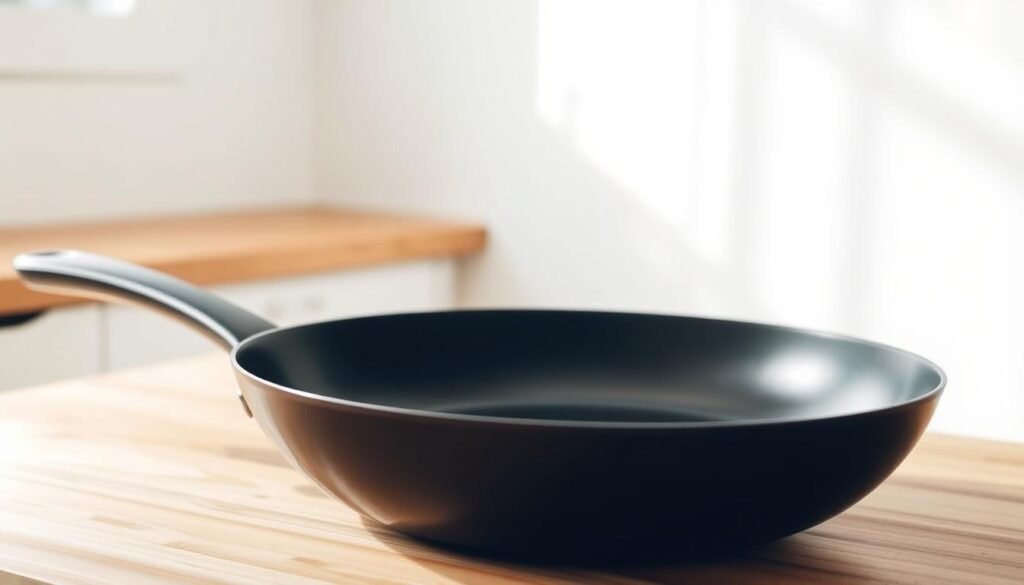
Specialized Nonstick Pans for Specific Cooking Tasks
For different cooking tasks, you need different pans. For example, to cook eggs without them sticking, you need a special pan. And for sautéing veggies, you need a pan that heats evenly.
Nonstick Pans for Perfect Eggs
To cook eggs well, you need a pan with a smooth surface. Reviews of nonstick skillets can show you the best pans for eggs.
Nonstick Sauté Pans for Versatile Cooking
A nonstick sauté pan is great for many dishes. You can use it to sauté veggies or cook proteins. Look for pans with a strong nonstick coating.
Deep Nonstick Pans for One-Pot Meals
Deep nonstick pans are perfect for cooking many ingredients at once. They’re great for making big, comforting meals.
Price Range and Value Considerations
Nonstick frying pans come in all price ranges. The price depends on the material, brand, and features. It’s important to think about the value you get for your money, considering how long the pan will last and how well it performs.
Top Brands and Their Reputations
Some brands are known for making high-quality nonstick pans. Reading nonstick frying pan reviews can help you choose. Brands that focus on quality and durability are usually worth the cost.
By looking at these factors and checking out what top brands offer, you can find the perfect nonstick frying pan. It will meet your cooking needs and preferences.
Proper Use and Care of Your Nonstick Frying Pan
To enjoy your nonstick frying pan for a long time, learn how to use and care for it. A well-maintained nonstick pan cooks food evenly and is easy to clean.
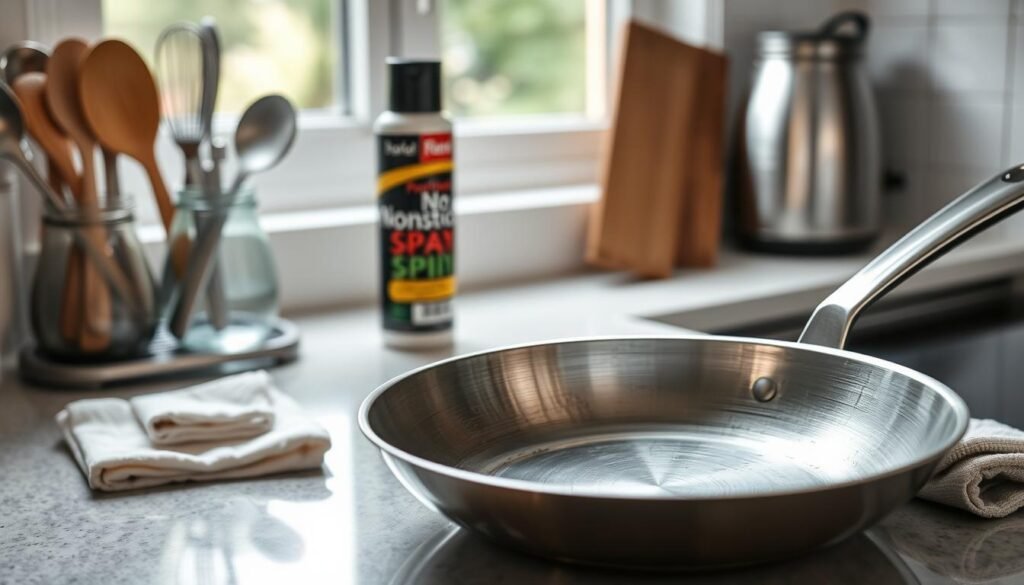
Safe Cooking Techniques for Longevity
To make your nonstick frying pan last longer, use safe cooking methods. Don’t cook at very high heat, as it can harm the nonstick coating. For cooking eggs or delicate foods, use medium heat.
Use silicone, wooden, or plastic utensils to cook with your nonstick pan for eggs or other foods. Metal utensils can scratch the pan’s surface. So, it’s best to avoid them.
Cleaning and Maintenance Best Practices
Cleaning your nonstick frying pan after each use is key to keeping it nonstick. Don’t use harsh cleaners or scouring pads, as they can damage the surface. Instead, clean it with mild soap and warm water. For tough residue, soak the pan first.
- Wipe the pan dry after washing to prevent water spots.
- Avoid stacking nonstick pans on top of each other to prevent scratching.
- For ceramic nonstick pans, avoid using metal utensils and abrasive cleaners.
Common Mistakes That Damage Nonstick Surfaces
Several mistakes can harm your nonstick frying pan’s surface. These include using metal utensils, cooking at too high a heat, and using harsh cleaners. Also, don’t put your nonstick pan in the dishwasher. The high heat and harsh detergents can damage the nonstick coating.
When to Replace Your Nonstick Pan
Even with proper care, your ceramic nonstick pan or other nonstick frying pans will need to be replaced. Look for signs like a worn or damaged nonstick coating, rust, or a decrease in nonstick performance.
By following these guidelines, you can enjoy your nonstick frying pan for a longer time. It will remain a valuable and reliable tool in your kitchen.
Conclusion: Why a Quality Nonstick Frying Pan Is Worth the Investment
A good nonstick frying pan makes cooking and cleaning up easy. Knowing the types of nonstick cookware helps you choose the right one. This includes traditional PTFE-coated pans and eco-friendly ceramic ones.
When picking a nonstick frying pan, look at durability, heat distribution, and how easy it is to clean. Many brands offer different prices, so reading reviews is key. This helps you find the perfect pan for your cooking style and budget.
Even though a quality nonstick frying pan costs more upfront, it’s worth it. With the right care, it lasts for years. This makes it a great choice for both home cooks and professional chefs. Choosing the right nonstick cookware means better cooking and more fun in the kitchen.
FAQ
What is the best nonstick coating for a frying pan?
How do I clean a nonstick frying pan?
Can I use metal utensils with a nonstick frying pan?
What are the benefits of using a nonstick sauté pan?
How do I choose the right size nonstick frying pan?
Are nonstick frying pan sets worth the investment?
How do I prevent food from sticking to my nonstick pan?
Can I put my nonstick frying pan in the dishwasher?
What are the signs that my nonstick pan needs to be replaced?

With over a decade of experience turning everyday ingredients into reliable, crowd-pleasing meals, Ryan knows firsthand the frustration of wasting time and effort in the kitchen. He specializes in clear, no-fuss guidance—breaking down techniques, time-saving tips, and smart shortcuts so that even complete beginners feel empowered and confident.
Subscribe to Our Newsletter
